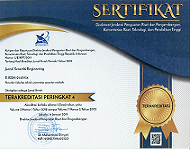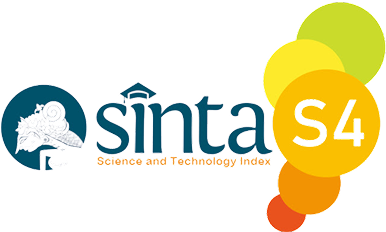Optimalisasi Produksi Biogas Melalui Penambahan Trace metals (Mo dan Zn) dengan Pemanfaatan Kotoran Sapi, Eceng Gondok (Eichhornia Crassipes) dan Sampah Organik pada Digester Batch Reactor
Keywords:
Biogas, trace metals, Molybdenum, seng, eceng gondok, kotoran sapi, Rasio C/N, CH4Abstract
Biogas production is now a practical solution to deal with organic waste while providing an environmentally friendly alternative energy source. This study was conducted to optimize biogas production by adding trace metals, namely molybdenum (Mo) and zinc (Zn), to a mixture of water hyacinth, fruit waste, and cow dung. The anaerobic fermentation process took place in a batch reactor for 35 days with four treatments: control without metals, addition of Mo 5 mg/kg, Zn 5 mg/kg, and a combination of Mo+Zn at 2.5 mg/kg each. Various parameters were measured, such as biogas volume and pressure, methane content (CH₄), carbon to nitrogen ratio (C/N), pH, temperature, and flame duration.The results showed that the addition of trace metals, especially the combination of Mo and Zn, significantly increased the amount and quality of biogas produced. The highest biogas volume was obtained in the treatment with Zn, while the best methane content appeared in the Mo+Zn combination. In addition, these trace metals help maintain pH stability and accelerate the active phase of fermentation. An ideal C/N ratio also supports the efficiency of methane production. In other words, the addition of these micro-nutrients strengthens the work of methanogenic bacteria and accelerates the conversion of organic matter into renewable energy.
References
[1] C. B. Kamandang, Z. R., Solin, D. P., & Casita, “Pemanfaatan Teknologi Biologis untuk Pengelolaan Sampah Organik.,” Jurnal Abdimas Teknik Kimia, vol. 2(1), 45–4, 2020, [Online]. Available: https://doi.org/10.33005/jatekk.v5i2
[2] M. L. Hakim, E. Kurniawan, J. Raharjo, and U. Telkom, “Desain Prototipe Alat Produksi Biogas Berbahan Dasar Limbah Organik dengan Monitoring” Jurnal Telatika, vol. 3, no. 1, pp. 8–12, 2023.
[3] D. Agustine, M. Amyranti, and I. Indriani, “Penerapan Teknologi Biogas Menggunakan Eceng Gondok (Eichhornia Crassipes) dan Limbah Organik Sebagai Upaya Mengatasi Pencemaran Lingkungan,” Prosiding TAU SNARS-TEK Seminar Nasional Rekayasa dan Teknologi, vol. 2, no. 1, pp. 58–64, 2023, doi: 10.47970/snarstek.v2i1.503.
[4] N. A. Irianto and M. Mirwan, “Efektivitas Tanaman Hydrilla Verticillata, Rumput Gajah, Eceng Gondok Dalam Pembuatan Biogas Dengan Bahan Dasar Kotoran Sapi,” Envirous, vol. 2, no. 1, pp. 48–55, 2023, doi: 10.33005/envirous.v2i1.64.
[5] N. Wahab and I. Ramli, “Analisis Pengolahan Biogas Dari Campuran Limbah Sayur Kangkung Dan Eceng Gondok Dengan Starter Kotoran Sapi,” Jurnal Tecnoscienza, vol. 6, no. 2, pp. 234–245, 2022, doi: 10.51158/tecnoscienza.v6i2.625.
[6] M. Mellyanawaty, F. M. Alfiata Chusna, and E. Nofiyanti, “Proses Peruraian Anaerobik Palm Oil Mill Effluent dengan Media Zeolit Termodifikasi,” Jurnal Rekayasa Proses, vol. 13, no. 1, p. 16, 2019, doi: 10.22146/jrekpros.39206.
[7] G. Angelin, “Pengaruh Penambahan Trace Metal (Molybdenum & Selenium) terhadap Pembuatan Biogas dari Sampah Organik dan Kotoran Sapi The Efect Of Trace Metal (Molybdenum & Selenium) Addition On Biogas Production From Organic Waste and Cow Manure,” Jurnal Teknik Kimia USU, vol. 6, no. 4, pp. 15–21, 2017.
[8] S. Myszograj, A. Stadnik, and E. Płuciennik-Koropczuk, “The Influence of Trace Elements on Anaerobic Digestion Process,” Civil and Environmental Engineering Reports, vol. 28, no. 4, pp. 105–115, 2018, doi: 10.2478/ceer-2018-0054.
[9] S. Mujdalipah et al., “Pengaruh Waktu Fermentasi Terhadap Produksi Biogas Menggunakan Digester Dua Tahap Pada Berbagai Konsentrasi Palm Oil-Mill Effluent dan Lumpur Aktif,” Jurnal AGRITECH, vol. 34, no. 1, pp. 56–64, 2014.
[10] O. Hijazi et al., “Environmental impacts concerning the addition of trace metals in the process of biogas production from anaerobic digestion of slurry,” J Clean Prod, vol. 243, p. 118593, 2020, doi: 10.1016/j.jclepro.2019.118593.
[11] M. Gani, Afdol, Jelita, “Potensi Biogas dari Campuran Jerami Padi dan Kotoran Ayam pada Suhu Mesofilik dan Termofilik dengan Rasio C/N Ideal” vol. 8, no. 2, pp. 305–318, 2025.
[12] Pujiati, Teknik Pengamatan Mikroba, vol. 11, no. 1. 2022. [Online]. Available: http://scioteca.caf.com/bitstream/handle/123456789/1091/RED2017-Eng-8ene.pdf?sequence=12&isAllowed=y%0Ahttp://dx.doi.org/10.1016/j.regsciurbeco.2008.06.005%0Ahttps://www.researchgate.net/publication/305320484_SISTEM_PEMBETUNGAN_TERPUSAT_STRATEGI_MELESTARI
[13] Libunelo, Dekri, Siti Aisa Liputo, and Marleni Limonu. "Kualitas Penyimpanan Susu Kacang Hijau Pasteurisasi Dengan Penambahan Ekstrak Daun Sirih." Jambura Journal of Food Technology 6.2 (2024): 231-242.
[14] Kisworo, Onno, and Fariz Amiruddin. Pengaruh Rasio C/N campuran Eceng Gondok Dan Serbuk Gergaji Serta Pra-Perlakuan Hidrotermal Terhadap Komposisi dan Volume Biogas Hasil Digesti Anaerobik. Diss. Universitas Brawijaya, 2019.
[15] Y. Yahya, T. Tamrin, and S. Triyono, “Produksi Biogas Dari Campuran Kotoran Ayam, Kotoran Sapi, Dan Rumput Gajah Mini (Pennisetum Purpureum cv. Mott) Dengan Sistem Batch,” Jurnal Teknik Pertanian Lampung (Journal of Agricultural Engineering), vol. 6, no. 3, p. 151, 2018, doi: 10.23960/jtep-l.v6i3.151-160.
Downloads
Published
Issue
Section
License
Copyright (c) 2025 Naufal Arhab, Mohamad Mirwan, M. Abdus Salam Jawwad, Maroeto (Author)

This work is licensed under a Creative Commons Attribution 4.0 International License.












